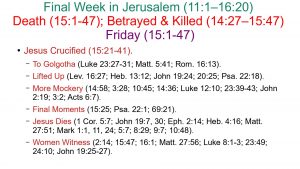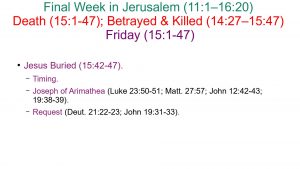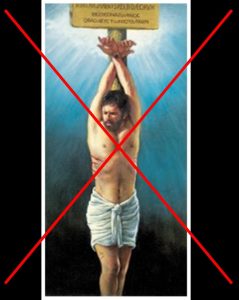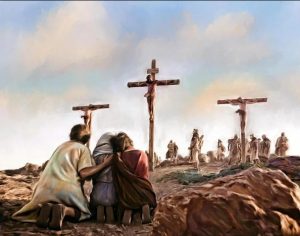Jesus’ Final Week in Jerusalem
Mark 11:1–16:20
Teaching (11:1–13:37)
King (11:1-11)
Sunday: Triumphal Entry (11:1-11).
Lawgiver (11:12–12:44)
Monday (11:12-19).
Tuesday (11:20–14:2).
Prophet (13:1-37)
Trial (14:1-72)
Sacrifice (14:1-26)
Wednesday (14:3-11).
Thursday (14:12-72)
Betrayed and Killed (14:27–15:47)
Death (15:1-47)
Friday (15:1-47).
Before Pilate (15:1-15).
Jesus Mocked (15:16-20).
Jesus Crucified (15:21-41).
To Golgotha (15:21).
Lifted Up (15:22-28).
More Mockery (15:29-32).
Final Moments (15:33-36).
As stated, Jesus died at the 9th hour, 3 PM, at around the same time the Passover Lamb was killed, assuming this is 14 Nisan, AD 33 (which is why we discussed it at length several weeks ago).
Christ, our Passover Lamb, was sacrificed at around the same time their Passover lamb was sacrificed (1 Cor. 5:7).
One of the terrible things about crucifixion is that, given the posture, it is difficult to exhale without pushing on your legs to do so.
This would cause the no doubt jagged wood of the cross to splinter into your back, one that was already ripped open by the earlier scourging.
So a loud voice would have been difficult, yet our Lord let one out, likely saying, “It is finished” as John records (19:30).
And then Jesus dies with this loud voice that was likely only understood by one close to Him at the time, John.
Then the veil of the temple was torn in two.
This is an indication that upon Jesus’ death, He torn down that “middle wall of separation” (Eph. 2:14).
Before, only the high priest was allowed entrance into the Most Holy Place having that access to God.
Now, after Jesus has died, that access is available for all! Praise God! (Heb. 4:16).
The old covenant has been done away to make way for the new in Christ.
There were several miraculous events that surrounded Christ’s death—Mark records two: the three hour darkness and this veil rent in two from top to bottom.
This was a clear indication who was responsible for all that was happening here.
Then there was the centurion who witnessed Jesus, how He died, the darkness and the earthquake (Matt. 27:51).
He heard the chief priests say that He made Himself out to be the Son of God (John 19:7).
And he realized that, “Truly this Man was the Son of God!”
This is a startling confession from a Gentile, awestruck at the sight of all that he had witnessed this day, and perhaps this entire week.
Mark starts off this gospel account with this admission (1:1) and proves it with the affirmations of the Father (1:11; 9:7) and the confessions of the demons (1:24; 5:7), the disciples (8:29), a blind beggar (10:48), and now this Gentile, a Roman centurion (15:39).
Who is this Jesus? Why, He is the Holy One of God, the Christ, the Son of David, and the Son of God the Most High.
Of course there’s no reason to think that this centurion had any concept of the full meaning of those words.
He might have thought this was some demigod like Hercules, half-god and half-man, son of the Greek god Zeus and a human woman.
While he may not have fully understood what he was saying, what he spoke was true nonetheless—Jesus was (is) the Son of God!
Women Witness (15:40-41).
Then we see the only ones who were watching who were supportive of Jesus, save John (John 19:26-27).
These were the women, many of whom supported Jesus in His ministry (Luke 8:1-3).
Mark records Mary Magdalene, Mary the mother of James the Less, and Joses, and Salome.
All Luke records is “the women who followed Him from Galilee” (Luke 23:49).
Matthew records these same women, but instead of Salome, he says the mother of Zebedee’s sons (James and John). Some conclude from this that Salome and the mother of James and John are the same person—I think that makes sense (Matt. 27:56).
John records a couple other women there, too: Jesus’ mother Mary and her sister, Mary the wife of Clopas, and of course Mary Magdalene and John himself (John 19:25-26).
It’s a speculation game trying to fit who are the same people in John’s account compared to Matthew’s and Mark’s, but there are anywhere from four to seven named women witnessing this gruesome sight.
But note, Mark also says, “many other women” were there, which could include Joanna the wife of Chuza (who was Herod’s steward) and Susanna (Luke 8:3).
Two of these three women listed here in Mark saw where Jesus was buried and all three of them would return Sunday morning after the Sabbath to anoint Jesus’ body, plus some others (15:47–16:1; Luke 24:10) – more later.
Mary Magdalene – a woman from Madgala on the west coast of the Sea of Galilee. Jesus had cast out seven demons from her (Luke 8:2).
Mary the mother of James the Less and Joses – James the Less is often identified with James the son of Alphaeus being the lesser known James among the Apostles. Joses is the Greek form of Joseph. If this is James the son of Alphaeus’s mother, then she may also be Matthew’s mother (2:14).
Salome – her name means peaceful, and could be James and John’s mother (Matt. 27:56).
These women stuck with Jesus up to the end, even after almost all the other male disciples fled.
It shows us the importance and steadfastness of women in the church—their immense value and a reminder that we can’t do this without them!
Timing.
Mark says that evening had come, which is an indication that this was late afternoon, after 3 PM.
It was the Preparation Day, which had come to be identified as Friday, the day before the Sabbath where they had to prepare to not work.
They had to prepare meals ahead of time and other things so they would be provided for without having to work for it.
They had just a few hours to prepare for sundown when the Sabbath had come.
Joseph of Arimathea.
Based on this verse and his mentions in the other gospel accounts, we still don’t know much about this man.
He is from Arimathea, which location is unknown today, though some identify it with Ramah from the OT, home of the prophet Samuel, in the ancestral area of Ephraim.
He was a member of the council, the Sanhedrin, who did not consent to Jesus’ execution (Luke 23:50-51).
Since it was a rule that one couldn’t be executed if everyone on the council voted guilty, then he may have been the one who allowed them to follow this one rule out of the many that they broke.
He was a rich man, which would factor in prophecy, as we’ll see (Matt 27:57).
He was a secret disciple of Jesus for fear of the Jews (John 19:38) – no doubt the fear was of his elite peers on the council since the common people loved Him.
He may be one of the ones described earlier in John 12:42-43 who loved the praise of men over the praise of God, not wanting to be kicked out of the synagogue.
The one who has much has much to lose should he go out on a limb like that.
But he was willing to come out and do the right thing now, along with his friend and fellow believer among the elite, Nicodemus (John 19:39).
I guess better late than never? Of course, as we see in hindsight, it was not too late, and Joseph’s name is known to all Christians and recorded in all four gospel accounts.
As we discussed earlier, in the OT, bodies were not permitted to stay hanging on a tree for longer than a day (Deut. 21:22-23).
Normally, the Romans would leave up crucified individuals for as long as possible to stand as a warning to others, but they often deferred to local laws and customs.
Since the local law here was to take the body down, the Romans were willing to defer to such laws to help keep the peace.
But we find that Pilate was amazed that Jesus had already died.
Depending on how a condemned man was crucified, it could take anywhere from days to 10 minutes to die.
In fact, this is how we know at least one JW teaching is wrong. Did you know they don’t believe Jesus was crucified on a cross? Their translation says “torture stake” rather than “cross.”
They believe Jesus was crucified like this: [picture]. They are rather insistent about it, too.
 The problem with this view is that, if Jesus’ were crucified like this, He would not have lasted six hours. Like this, He would have lasted anywhere from ten to thirty minutes (Jeremy Ward, Physiologist at King’s College London).
The problem with this view is that, if Jesus’ were crucified like this, He would not have lasted six hours. Like this, He would have lasted anywhere from ten to thirty minutes (Jeremy Ward, Physiologist at King’s College London).Pilate would not have been shocked had Jesus been crucified this way.
Someone nailed to a cross would have lasted no more than 24 hours—which explains why Pilate was so surprised that Jesus was dead after only 6.
He expected Jesus to have needed some help dying as the thieves did, by breaking their legs, so they could be taken down before sundown (John 19:31-33).
Pilate was so shocked, he asked his centurion to check it out.
When it was confirmed that Jesus had actually been dead “for some time,” Pilate grants the body to be given to Joseph.



